Why Your Fence Deserves More Than Neglect
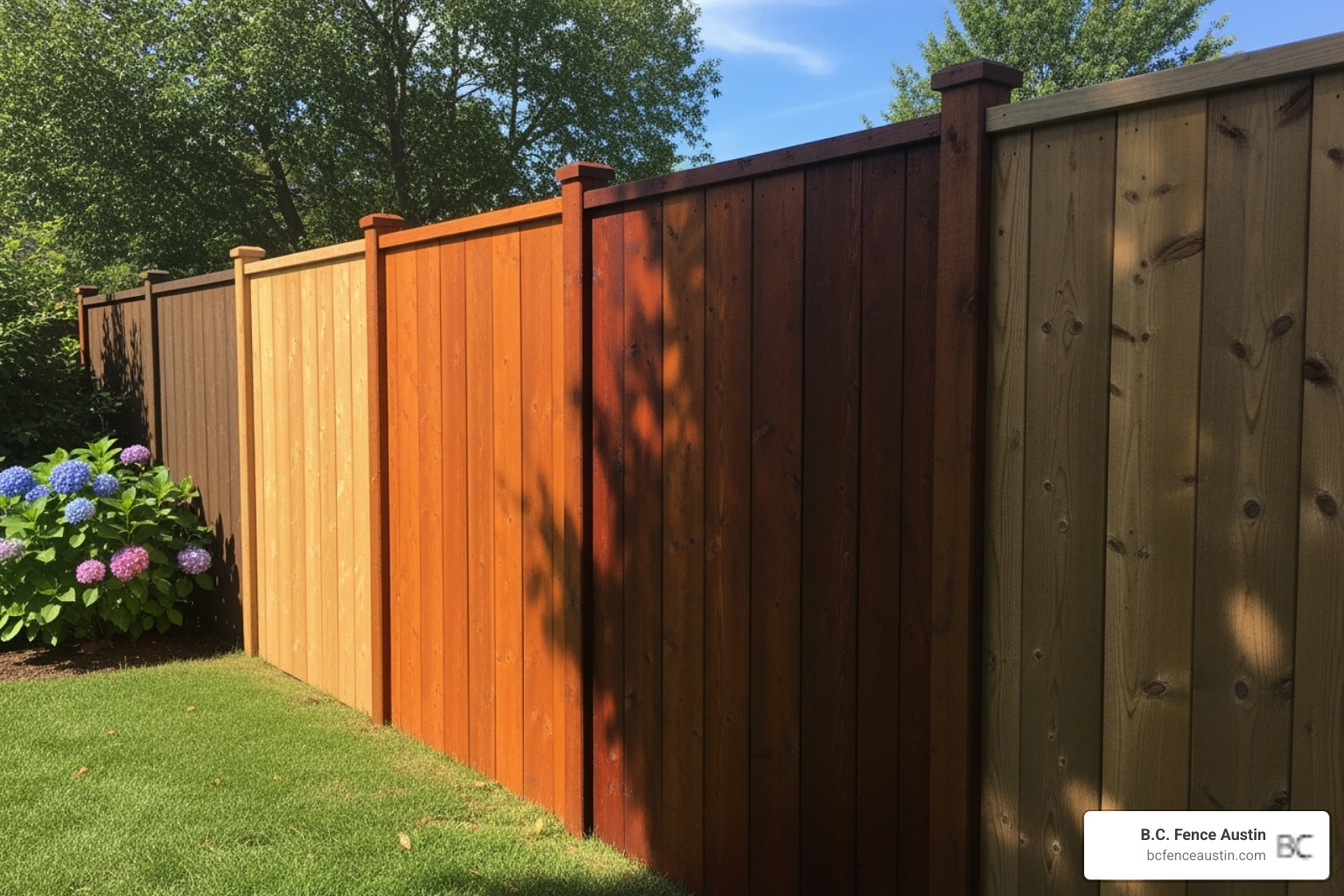
Fence stain ideas can transform your backyard from drab to dramatic while protecting your wood investment from Austin’s intense sun and unpredictable weather. The right stain color boosts curb appeal, complements your home’s exterior, and can even increase property value.
Quick Answer: Top Fence Stain Ideas
- Natural Tones: Cedar, redwood, and chestnut for timeless warmth
- Modern Grays: Weathered gray, charcoal, and slate for contemporary style
- Bold Colors: Deep blue, olive green, or black for statement-making appeal
- Stain Types: Transparent (shows grain), semi-transparent (some color), solid (full coverage)
- Frequency: Re-stain every 2-3 years in Austin’s climate
Beyond aesthetics, a fresh fence stain is crucial for protection. It shields wood from UV rays that cause fading and cracking, creates a moisture barrier to prevent rot, and can add years to your fence’s lifespan. This protection is essential in Austin’s climate, with its intense sunlight and heavy rains.
Today’s options go far beyond traditional browns. Trending gray wood stains offer a modern, weathered look, while a spectrum of other colors allows you to express your personal style. Whether you prefer the classic appeal of natural wood or a bold, contemporary statement, there’s a fence stain to fit your home.

Before You Pick a Color: Understanding Fence Stains
Before choosing a shade, it’s important to understand the different types of stains. The type of stain you select is key to achieving your desired look and getting the protection your fence needs. It affects how much wood grain shows through, how long the finish lasts, and how often you’ll need to reapply.
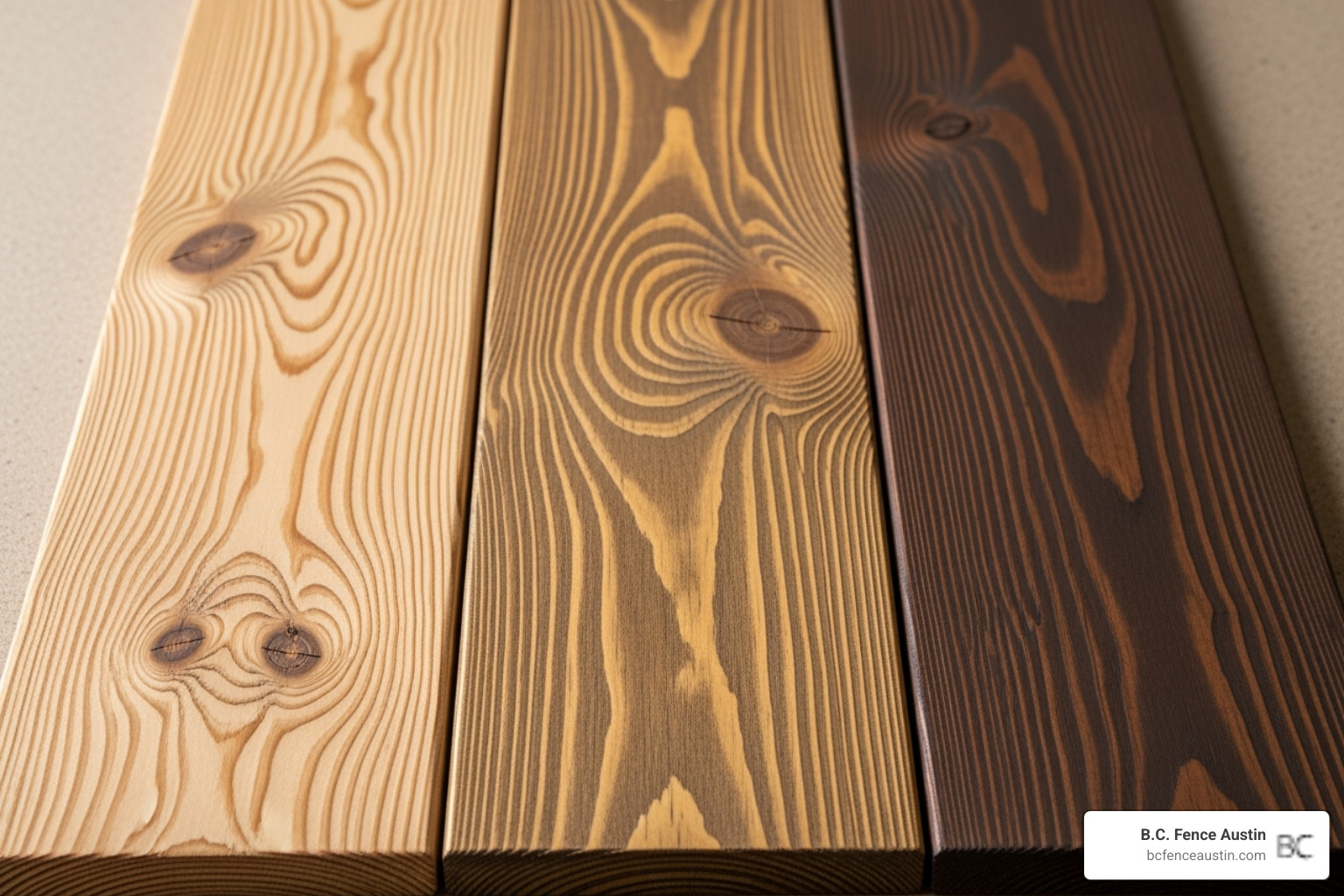
While paint provides a solid, uniform look, stain penetrates the wood to protect it from UV rays and moisture while letting its natural texture shine through. This is critical in Austin’s climate. For a detailed comparison, our guide on Should I Paint or Stain My Wood Fence? can help you decide.
Stain Opacity: From Natural to Solid
Opacity determines how transparent the stain is and how much wood grain remains visible.
Transparent stains have very little pigment, allowing the wood’s natural grain and color to show through almost completely. They offer a hint of color and basic protection against UV rays and moisture, ideal for new cedar or redwood fences where you want to preserve the fresh-cut look.
Semi-transparent stains offer a balance of color and transparency, letting the wood grain remain visible. This is a popular choice for many homeowners in areas like Cedar Park and Round Rock, as it improves the wood’s character while providing good weather protection.
Semi-solid stains contain more pigment, providing richer, more uniform color that still allows some wood grain to peek through. They are excellent for hiding minor imperfections and offer substantial protection.
Solid color stains completely cover the wood grain, resembling paint but with better penetration. They provide maximum protection against UV damage and moisture, making them perfect for older fences or when a bold, uniform color is desired. Apply them carefully to avoid cracking and peeling.
Stain Base: Oil vs. Water
You’ll also choose between an oil-based or water-based stain.
Oil-based stains are a traditional choice known for deep penetration and creating a strong barrier against moisture. They dry slowly, which helps avoid lap marks and results in a rich, deep color. The downsides include the need for mineral spirits for cleanup and higher VOC levels. For maximum durability in harsh weather, oil-based stains are a reliable option.
Water-based stains are eco-friendly, have low VOCs, and clean up easily with soap and water. They dry faster, so you need to work quickly to ensure an even coat. Modern formulas offer excellent durability and protection, making them a great choice for those who prioritize convenience and lower environmental impact.
Both types effectively protect your fence. The choice often comes down to your project timeline, environmental concerns, and personal preference.
Top Fence Stain Ideas to Boost Curb Appeal
The right fence stain ideas can turn your fence into a stunning design feature. Today’s options go far beyond traditional browns, ranging from soft, natural tones to bold statement colors that can redefine your backyard’s personality.
Timeless Naturals: Enhancing the Wood’s Beauty
Natural-toned stains improve the authentic beauty of wood, highlighting its grain and texture while adding a protective shield against Austin’s weather.
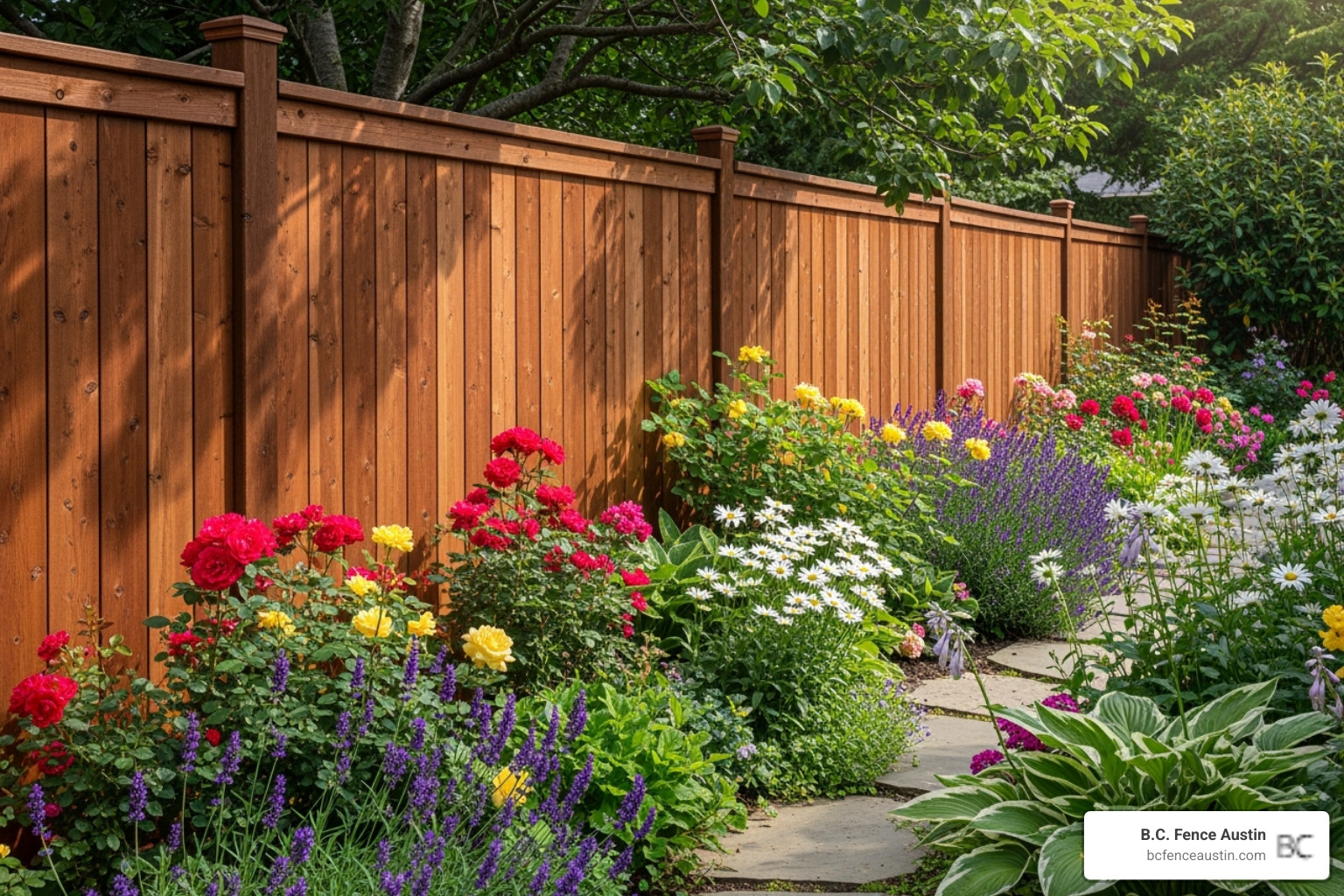
Cedar stains create a welcoming, rustic elegance. These warm tones blend seamlessly with garden landscapes and homes with neutral siding, creating an inviting outdoor space.
Redwood stains deliver a richer, more dramatic look. These deep, sophisticated hues create a stunning contrast against lighter home exteriors or brick, grounding your property with a timeless feel.
Chestnut offers a cozy warmth that adds character without feeling too dark. It’s a versatile shade perfect for creating an inviting atmosphere.
Natural tones are a safe bet for a look that won’t feel dated. To learn more about how different woods pair with stains, see our guide on Cedar vs Redwood Fence: The Ultimate Guide to Wood Durability.
Modern & Moody: Trending Fence Stain Ideas
Gray tones bring a sleek, sophisticated edge to your property that feels fresh and current. These modern, moody fence stain ideas are a major trend in home design.
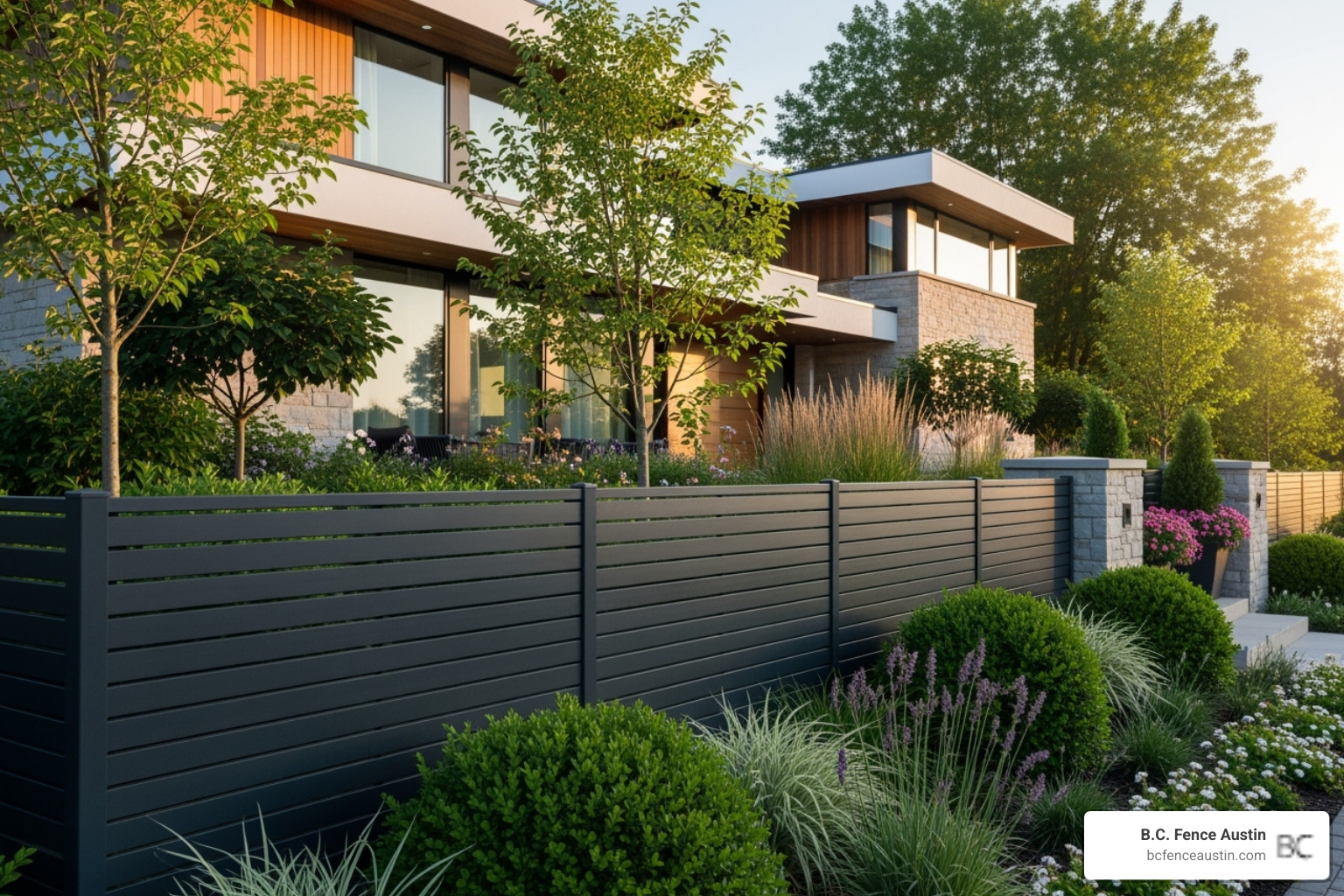
Charcoal gray is a bold, crisp choice that creates striking contrast against greenery and lighter home exteriors. It gives your fence a strong, ultra-modern look.
Weathered gray mimics the natural aging process of wood, giving your fence a chic, relaxed vibe. It blends beautifully into natural surroundings while maintaining a modern aesthetic.
Black stain is an increasingly popular choice for a dramatic effect. It makes garden plants and vibrant landscaping pop, creating a gallery-like backdrop for your outdoor space.
Espresso brown is a warmer alternative to black, offering a sophisticated, moody feel. This deep, rich tone can transform your backyard into a secluded retreat.
These modern shades are perfect for contemporary architectural styles. For more inspiration, explore fence color ideas on Houzz.
Bold & Beautiful: Unique Fence Stain Ideas
For those who want to make a statement, unique stain colors can transform a fence into an artistic centerpiece.
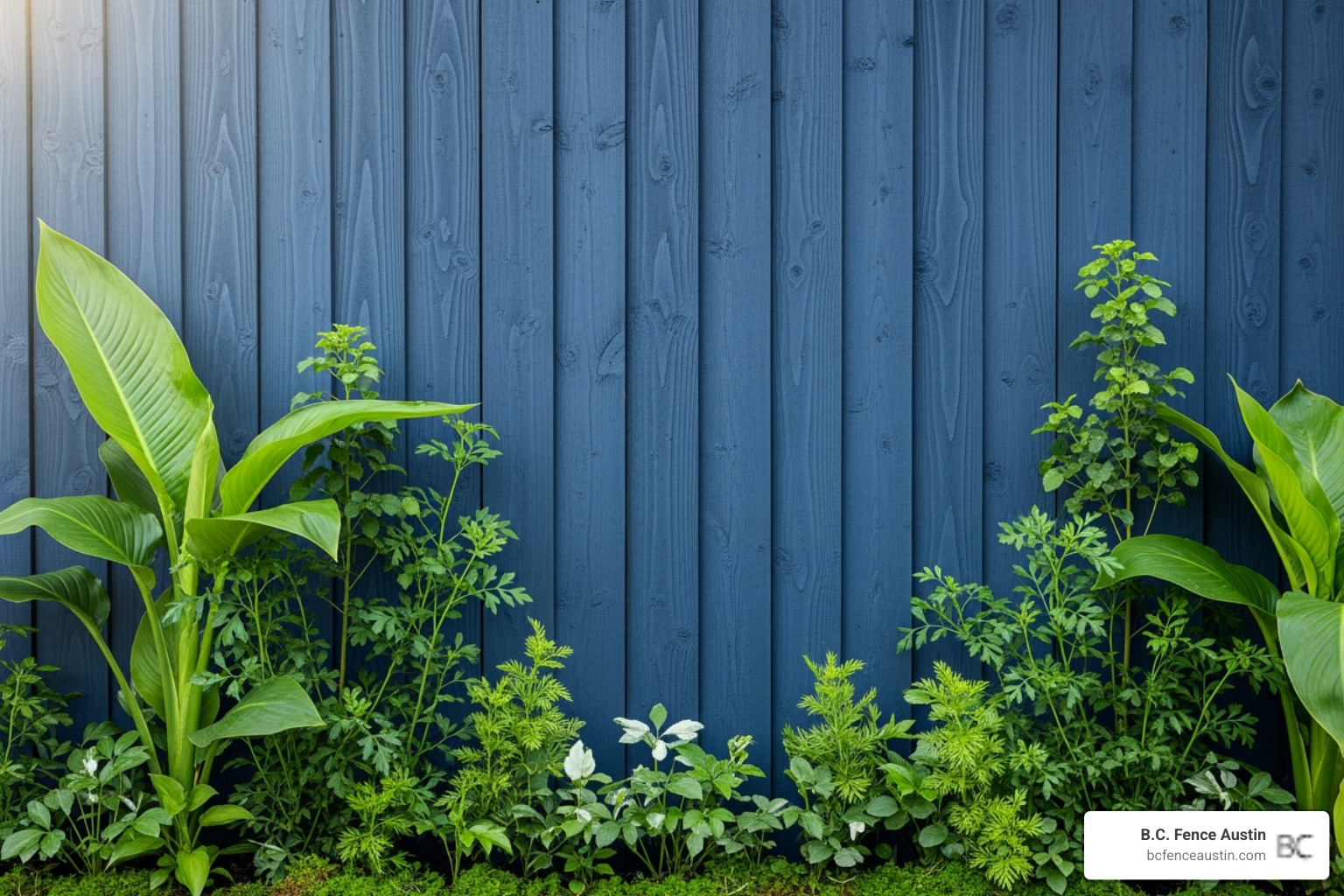
Deep blue is a sophisticated showstopper. These rich, regal tones add an artsy pop of color that can create a coastal vibe or a serene backdrop.
Olive green stains blend harmoniously with foliage, making your fence feel like a natural extension of your garden.
Slate blue offers noticeable color with restraint. It provides a cool, sophisticated balance to warmer materials like stone or brick.
Dark yellow (or honey gold) provides a look that feels both classic and avant-garde. It’s a warm, approachable head-turner that adds unique character.
How to Choose the Perfect Stain Color for Your Home
Choosing a fence stain is like selecting an accessory for your home—it should complement what’s already there while reflecting your personal style. The right fence stain ideas unify your property for a polished look.
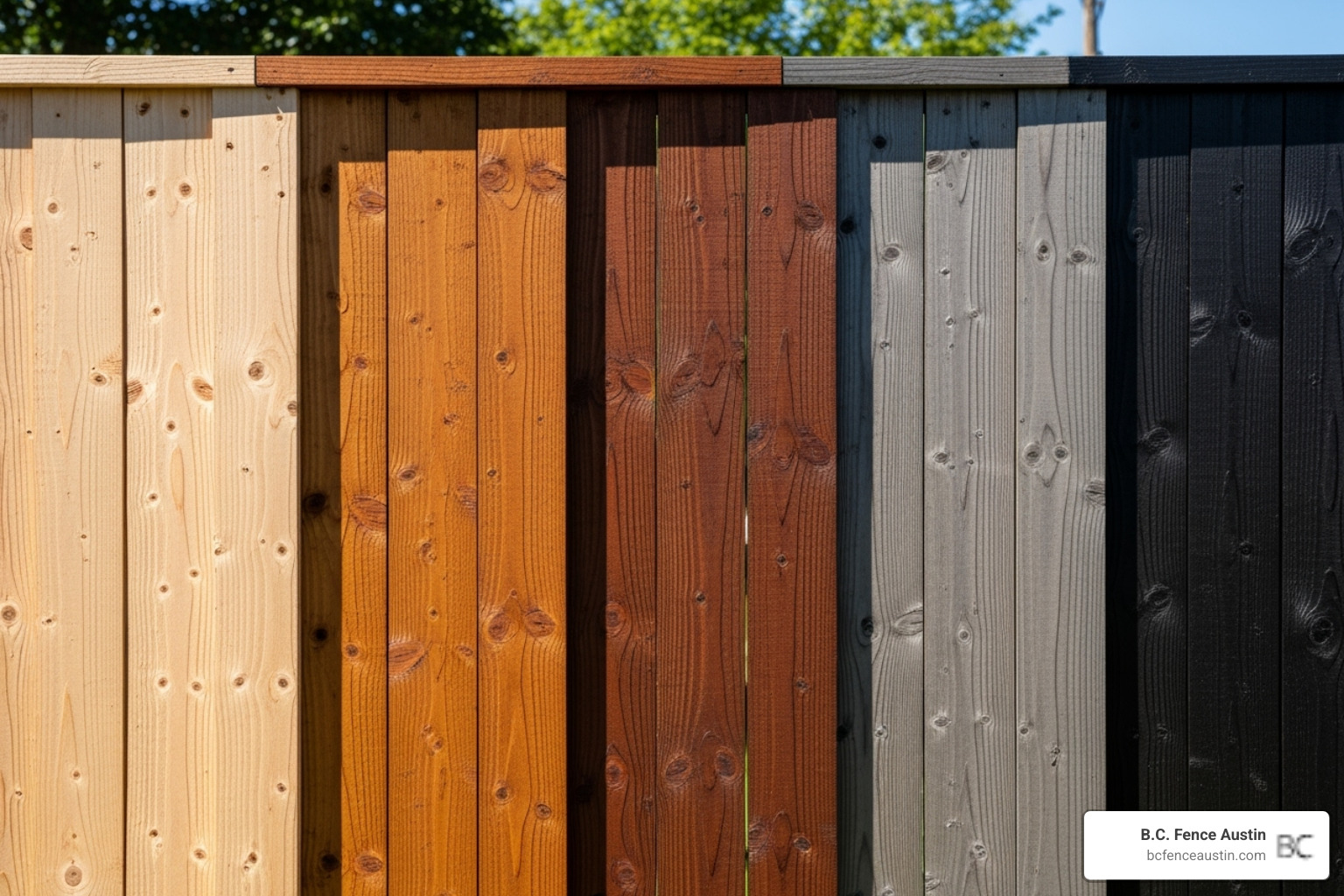
Before committing, use a digital tool to preview colors. Stain brand visualizers, like Olympic’s Stain Visualizer, let you test shades on project photos, making it easier to experiment.
Coordinating with Your Home and Landscape
For a cohesive look, your fence must work with your home’s exterior and landscaping.
Start with your home’s exterior colors, including siding, roof, and trim. Neutral siding (white, beige, light gray) allows for freedom—a dramatic charcoal gray fence can create striking contrast. With darker exteriors, a lighter stain can provide balance, while a matching dark tone creates a sleek, unified look.
Consider brick or stone accents. A warm cedar stain can echo the earthy tones in natural stone. If you have red brick, see how different stains interact with its warm tones.
Your landscaping is also a key factor. An olive green stain can make your fence blend into lush greenery, creating the illusion of a larger garden. A neutral fence color allows vibrant flower beds to take center stage, while a deep blue stain can be a stunning backdrop that makes bright flowers pop.
Step back and view the big picture. A cohesive color scheme creates a sense of intentional design that lifts your entire outdoor space.
Considering Wood Type and Sun Exposure
The type of wood and its sun exposure will affect the final appearance of your stain.
The natural wood color impacts how the stain looks. Pine is light and absorbs stain deeply. Cedar has reddish undertones that are beautifully highlighted by semi-transparent stains. Redwood has a naturally bold hue that adds depth to any stain.
Always test your chosen stain on a hidden spot of your fence. Let it dry completely to see the true color, as it can look different from the sample chip.
Sun exposure is a crucial factor in Austin. Intense sun can fade colors quickly, so UV protection is essential. Dark stains hide dirt well but can show fading more noticeably. Lighter stains show dirt more easily, but fading is often more gradual. Know what to expect and plan for maintenance.
Monitor your fence for fading or a washed-out appearance, which signals it’s time for a refresh. Regular maintenance extends your fence’s life. For more detailed guidance, see our guide on Cedar Fence Maintenance.
The Staining Process: From Prep to Perfection
Once you’ve chosen your color from the many fence stain ideas, success hinges on proper preparation and application. A great finish starts with a clean, well-prepped surface.
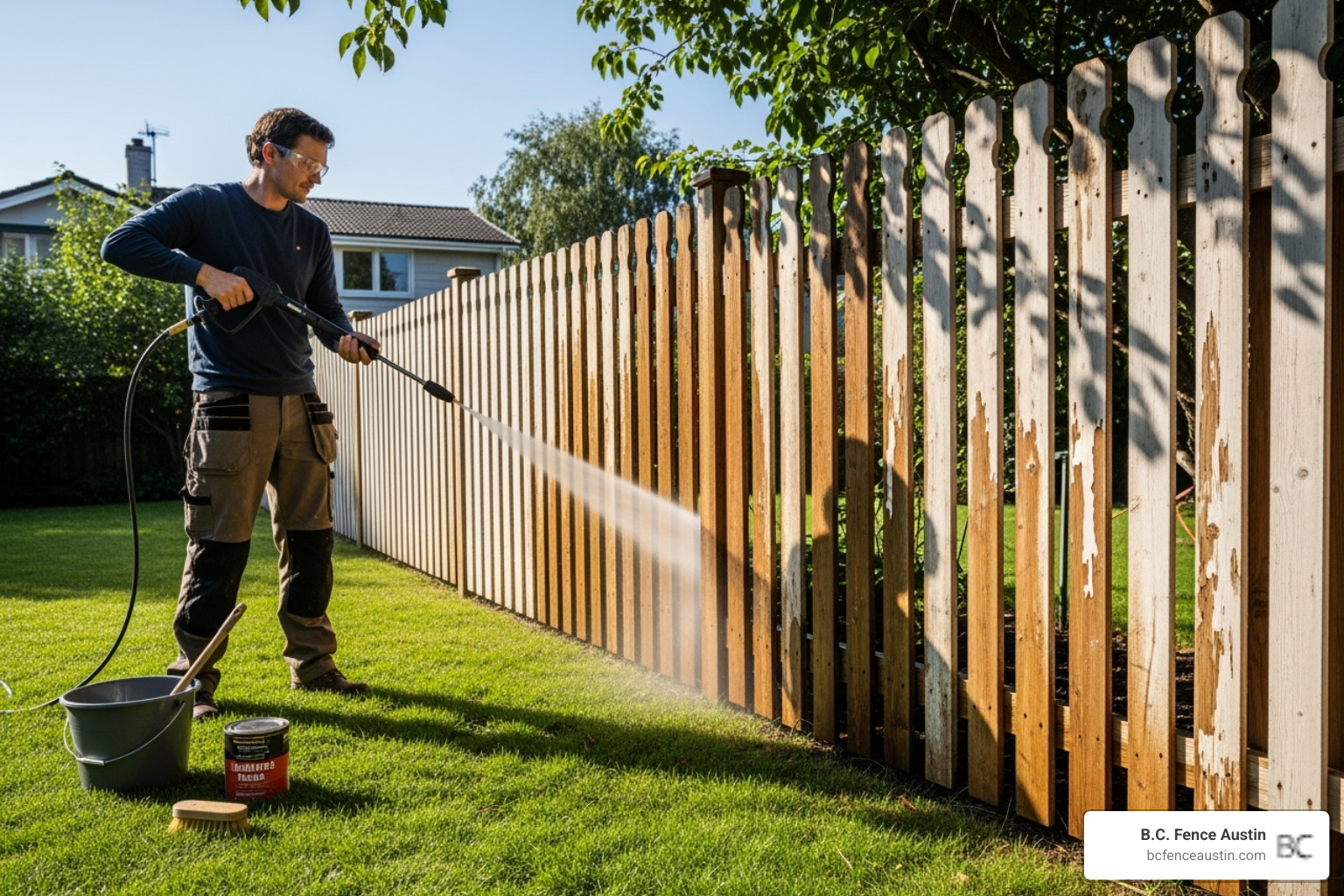
Preparing Your Fence for a Flawless Finish
Proper prep ensures the stain absorbs evenly. First, conduct a thorough fence inspection. Look for and fix any loose boards, protruding nails, or damage. For help with fixes, see our article on the Best Way to Fix a Wooden Fence.
Next, perform a thorough cleaning. The fence must be free of dirt, mildew, and old, peeling finishes. A power washer can be effective, but use gentle pressure to avoid damaging the wood. Our guide on How to Clean a Wood Fence provides detailed instructions.
Allow the fence to dry completely—usually for two full days—before staining. Applying stain to a damp fence will result in a blotchy, peeling finish.
For the best absorption, especially on new or repaired wood, light sanding opens up the wood grain, creating a perfect canvas for your stain.
Application and Long-Term Care
With a prepped fence, it’s time to apply the stain. Always work in the direction of the wood grain.
- Brushes are best for detailed work and ensuring good penetration.
- Rollers cover large, flat surfaces quickly but should be followed by a brush to work the stain in.
- Sprayers are the fastest method for large fences but require careful technique and back-brushing to avoid overspray and ensure even coverage.
How long your stain lasts depends on the stain type, wood, and climate. In Austin’s intense sun, we recommend re-staining your fence every 2-3 years. This proactive approach protects your investment from rot and warping.
Regular maintenance is key to preserving your fence’s beauty and integrity. For more year-round advice, read our Wood Fence Maintenance Tips. By following these steps, you’ll achieve a stunning look that protects your fence for years to come.
Frequently Asked Questions about Fence Staining
We get a lot of questions about fence stain ideas from homeowners in Austin, Cedar Park, and Round Rock. Here are answers to some of the most common ones.
What is the most popular fence stain color?
Timeless natural wood tones like cedar and redwood are always popular for their ability to highlight the wood’s inherent beauty. However, modern gray tones, from light weathered gray to dark charcoal, are currently trending. These shades offer a sophisticated, contemporary vibe that is very popular. The best choice depends on your home’s style and the look you want to achieve.
How often should I stain my fence?
Generally, a fence should be re-stained every 2 to 5 years. However, in Austin’s climate, with its intense sun and humidity, we recommend re-staining every 2-3 years. This frequency is crucial for protecting the wood from UV damage, moisture, and premature aging. Check your fence annually for signs of fading or wear, as that’s a good indicator it’s time for a fresh coat.
Can I apply a new stain over an old one?
Yes, but proper preparation is non-negotiable. The fence must be thoroughly cleaned of all dirt, mildew, and any loose or peeling old stain to ensure the new coat adheres properly. If the old finish is in poor condition, sanding may be necessary. It’s much easier to apply a darker stain over a lighter one. To go from a dark to a light color, you will likely need to strip the old stain or use a solid color stain to achieve full coverage. Always test the new stain on a small, hidden area first.
Conclusion
Your fence is more than a boundary; it’s a canvas for boosting your home’s curb appeal. As we’ve explored, the right fence stain ideas not only protect your investment but also create a beautiful backdrop for your outdoor life. From understanding stain types to choosing between timeless natural tones and trending grays, you’re now equipped to make a confident decision.
A beautifully stained fence shields your wood from Austin’s harsh weather while reflecting your personal style. The key to a lasting, stunning result is proper preparation—a clean, repaired surface is essential for any stain to perform its best. In our Texas climate, this attention to detail ensures your fence will thrive for years.
A well-maintained fence is a valuable asset that adds beauty and value to your home. If you’re ready to transform your backyard with professional expertise, the team at B.C. Fence Austin is here to help homeowners throughout Austin, Cedar Park, and Round Rock.
Ready to bring your vision to life? Explore our wood fence services and find how we can create an outdoor space you’ll love.
